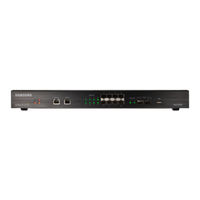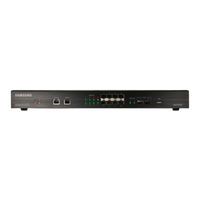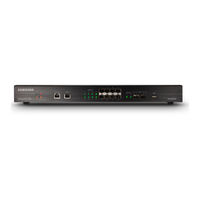Samsung WEC8050 Manuals
Manuals and User Guides for Samsung WEC8050. We have 6 Samsung WEC8050 manuals available for free PDF download: Operation Manual, Maintenance Manual
Samsung WEC8050 Operation Manual (680 pages)
access point controller
Brand: Samsung
|
Category: Control Unit
|
Size: 13.52 MB
Table of Contents
-
Preface
16 -
-
APC Overview20
-
-
-
-
-
Using Web UI42
-
-
Overview49
-
-
-
-
Qos115
-
Time Profile120
-
Os-Aware123
-
IGMP Snooping130
-
-
Mdns Snooping142
-
Ipv6 Station145
-
-
APC Management146
-
-
-
AP Management157
-
AP Configuration191
-
-
-
Local Switching235
-
-
DHCP Relay261
-
DHCP Proxy262
-
-
Advertisement
Samsung WEC8050 Operation Manual (689 pages)
Wireless Enterprise Access Point Controller
Brand: Samsung
|
Category: Wireless Access Point
|
Size: 14.64 MB
Table of Contents
-
-
-
-
-
Bridge72
-
Time Profile132
-
Os-Aware135
-
-
-
Igmp Snooping
141 -
Mdns Snooping
154
-
-
AP Management
170-
-
AP Configuration202
-
-
-
Local Switching
244 -
-
-
-
Dhcp Server262
-
Dhcp Pool263
-
Dhcp Relay270
-
DHCP Proxy271
-
-
Samsung WEC8050 Operation Manual (496 pages)
Access Point Controller
Table of Contents
-
-
-
-
-
Time Profile114
-
Os-Aware117
-
IGMP Snooping122
-
-
AP Management138
-
-
AP Group Profile146
-
AP Configuration149
-
-
Local Switching173
-
-
-
Dhcp Pool190
-
-
-
-
N Configuration211
-
-
H Configuration221
-
Country Code223
-
-
Clustering256
-
-
-
Detection283
-
-
Captive Portal300
-
WEB Pass-Through305
-
MAC Filter313
-
-
SNMP Trap328
-
-
System Info331
-
-
-
System Reboot335
-
-
Upgrade354
-
File Management365
-
Revising File367
-
Ip | | |-- Dhcp387
-
Lease387
-
Pool387
-
Dhcp-Proxy388
-
Dns388
-
Igmp388
-
Name-Server388
-
Relay388
-
Route388
-
Snooping388
-
Ssm-Map388
-
Access-List389
-
Interface392
-
Pim392
-
Sparse-Mode392
-
A.2 Show403
-
Advertisement
Samsung WEC8050 Operation Manual (534 pages)
Controller
Brand: Samsung
|
Category: Wireless Access Point
|
Size: 9.37 MB
Table of Contents
-
Purpose3
-
APC Overview19
-
-
Bridge56
-
Time Profile116
-
Os-Aware119
-
IGMP Snooping125
-
APC Management128
-
AP Management140
-
AP Configuration163
-
-
Local Switching201
-
Dhcp Pool219
-
DHCP Relay226
-
DHCP Proxy227
Samsung WEC8050 Operation Manual (673 pages)
Wireless Enterprise
Access Point Controllers (APC)
Brand: Samsung
|
Category: Controller
|
Size: 13.46 MB
Table of Contents
-
-
-
-
Add-Ap [AP_NAME]165
-
Acl-Profile184
-
Remote-Group210
-
Airinsight589
-
Network-Stats589
-
Statistics589
-
Air-Quality590
-
-
Noise-Level590
-
Station590
-
Rx-Utilization590
-
Tx-Utilization590
Samsung WEC8050 Maintenance Manual (88 pages)
WLAN Controller
Brand: Samsung
|
Category: Controller
|
Size: 1.8 MB
Table of Contents
-
Purpose3
-
-
Snmp32
-
Access Error40
-
Login Error42
-
Advertisement





